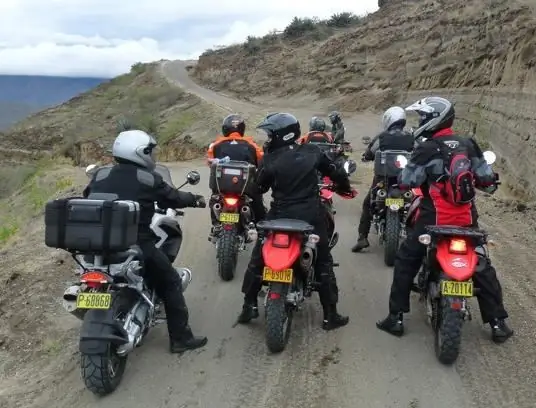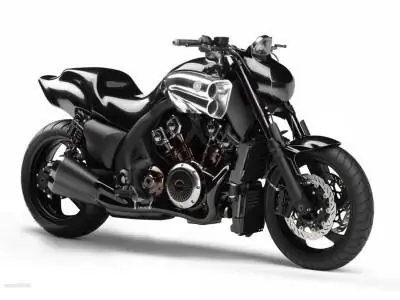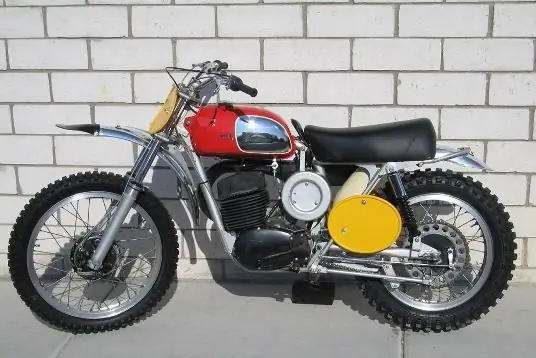2026 Author: Erin Ralphs | [email protected]. Last modified: 2025-01-22 21:14:11
Few people know, but the history of the creation of motorcycles began quite by accident. The engineer-inventor Gottlieb Daimler, who lived in Germany at the end of the nineteenth century, spent a long time in his workshop developing a gasoline engine. He managed not only to assemble a working unit, but also to make a design very similar to modern motor vehicles. The man did not at all think of inventing a motorcycle, but only wanted to test the operation of the engine. On August 29, 1885, he drove out of his huge yard in a two-wheeled vehicle powered by a gasoline power unit. It is this day that is considered to be the beginning of the era of motorcycle construction.

Domestic production
The domestic history of motorcycles began in 1913. It was at the dawn of the twentieth century that attempts were made to organize the import of parts from Switzerland, as well as to organize the assembly of light motorcycles. For this, production facilities at the plant were allocated"Dux", located in the capital. But due to the outbreak of the First World War, the conveyor had to be stopped.
The first non-serial motorcycle, which was assembled on the territory of the USSR, is considered a model called "Soyuz". It was designed thanks to the enthusiasm of a whole group of Moscow engineers working under the direction of P. N. Lvov. The model received a fairly powerful single-cylinder four-stroke power unit, the working volume of which was 500 cm3. Although development was a success, mass assembly was not possible as the plant changed its business profile.
Already four years after the first model was assembled and tested in Moscow, the history of domestically produced motorcycles was continued. In Izhevsk, it was decided to create a design bureau, the main task of which was motorcycle construction. The group of specialists was headed by Pyotr Mozharov, who was considered one of the most talented engineers of those times. Under his leadership, painstaking design work began, and after a few years, as many as five motorcycle models were created, which successfully passed all the tests and were ready for mass production. This is how the history of the creation of the IZH motorcycle began.
Tales from Izhevsk
The history of motorcycles IZH began with models that were called IZH-1 and IZH-2. They were equipped with a two-cylinder V-shaped power unit, the volume of which was 1200 cm3. At maximum loads, this engine is capable of delivering 24 hp. s., which at that time was not badresult. As soon as the motorcycles entered serial production, the following models were designed and tested, such as IZH-3, 4 and 5.

IZH-3 received a V-shaped two-cylinder engine, the volume of which was much smaller than that of its predecessors, and amounted to 750 cm3. The lightest and liveliest in the lineup was the IZH-4, which was equipped with a two-stroke engine with one cylinder. IZH-5, which received the attractive name "Composition", borrowed the power plant from the Neander motorcycle, but had no external resemblance to it.
Only having a ready-made model range, the leadership of the Soviet Union seriously thought about building a factory where domestic motorcycles would be assembled. At this point in the country there were several design bureaus at once, which were located in Leningrad, Izhevsk, Kharkov and Moscow. After a commission of experts from the Presidium of the Supreme Council of National Economy of the USSR was assembled and this issue was studied in detail, it was decided to build a motorcycle plant in the city of Izhevsk.
In 1933, the first motorcycles left the assembly line, and the designers continued to work on new models. However, due to the outbreak of war, all projects had to be frozen. The designers returned to their duties only in 1946, after which mass production of motorcycles of the Saturn, Orion, Sirius, and Saturn series was launched.
IZH-Planet
In 1962, the history of the IZH-Planet motorcycle began, which became a real legend in the domestic motorcycle industry. The older generation, who lived for many years in a country withsocialist system, probably remembers how almost all the guys dreamed of having IZH-PS ("Planet Sport"). Models representing this line are often found on city roads today.
History of motorcycles "Minsk"
Minsk motorcycle and bicycle plant began its activity in the post-war period, namely in 1945. It became possible to launch production facilities thanks to imported equipment, which was brought from the territory of Germany, which announced its surrender. For the first six years, only bicycles were produced, and already in 1951, the serial assembly of motorcycles began.
The first bike that left the factory was Minsk-M1A, which had much in common with its foreign counterparts. For example, the front of the bike was very similar to the German DKW-RT125, which turned out to be incredibly successful. The DKW-RT125 was so well thought out that the development of German designers became interested not only in the Soviet Union, but also in countries such as Japan, the USA and Great Britain.

Time passed, and it was necessary to change the appearance of motorcycles to a more modern one. The country's leadership instructed the plant's designers to work not only on the exterior, but also to increase the durability of the structure. It is worth noting that the factory workers approached the task with full responsibility, and in 1974, on the eve of the Constitution Day of the USSR, the MMV3-3.111 road motorcycle model was presented. However, the history of motorcycles assembled by Belarusian specialists did not end there.
Handsome M-106
The sympathies of Soviet citizens were given to the bike, called M-106. This handsome man had a combined color in two colors (cherry and black). But the main feature was that, despite the serious differences from their predecessors, 84% of the parts were interchangeable. That is, if, for example, a piston group fails, a similar part taken from another model of the Minsk motorcycle can be used for repair.
Ural (IMZ)
The history of motorcycles "Ural" originates in the pre-war years. Several factories located in Leningrad, Kharkov and Moscow at once received an assignment from the government: to make a domestic analogue of the German BMW R71 motorcycle. To do this, five units of foreign equipment were bought in Sweden, which were secretly transported to the Soviet Union.
Work on the "cloning" began in 1941, and before the outbreak of hostilities, three motorcycles were created, which entered service in the Soviet army. The design was equipped with the Konkurs-M anti-tank installation. However, due to the war, production facilities had to be moved east, to the small Ural city of Irbit. It was here that mass assembly was established. Despite the ongoing work, it was not possible to satisfy the army's need for motor vehicles. In order to get out of a difficult situation, the state was forced to purchase equipment in the US and the UK until the end of World War II.
Motorcycles for civilians
Despite the fighting, the plant was able not only to survive the colossaldifficulties, but also continued to work after the surrender of Nazi Germany. The first motorcycle, called "Ural", rolled off the assembly line in 1960. It was the M-61 model, which had been assembled at the IMZ for three years.

There were not only black stripes in the history of Ural motorcycles. After the M-61 line, the M-63 series appeared. She could boast of bikes, the characteristics of which were at the level, and sometimes even surpassed their best foreign counterparts. Strela and Cross-650 are considered the most successful.
The Ural index was used until 1976. It was during this period that the M 67-37 model appeared, which became the last in the line. The IMZ is still in operation today. The company has made a serious rebranding and assembles motorcycles that can compete with any world leader.
Sunrise
The history of Voskhod motorcycles began in 1965. These bikes replaced the K-175 model, which was also assembled at the plant. Degtyarev. Like all other motorcycles, Voskhod has strengths and weaknesses. The latter can be safely attributed to the cost of a new motorcycle, as well as the simplicity of its design. It was more affordable for average citizens than IZH or Java, and not so whimsical to maintain.
"Sunrise", as a rule, was bought by inexperienced drivers who were poorly versed in the technical part of the device itself. This is due to the fact that there are no complex components and assemblies in the design, and you can fix the breakdown right on the road, having a minimum of tools with you. However, this is not at allmeans that the motorcycle did not need service. The more attention was paid to the prevention and lubrication of all mechanisms, the less breakdowns were.
2M and 3M
In 1976, Voskhod-2M motorcycles appeared on sale, which were a modified version of their predecessor. There were no cardinal changes, however, the engine of a light domestic bike became a little faster, the head optics became of better quality. The suspension received improved shock absorbers, and the front fork was completely replaced.

In 1954 Voskhod 3M rolled off the assembly line. It proved to be excellent and was produced for eight years. 3M received a better cooling system, head optics with a European-class light diffuser. The dashboard has also undergone changes, which displayed not only the usual indicators of temperature, turns and a speedometer, but also a brake pad wear indicator.
Java Motorcycles: History of Models
These motorcycles have quite an interesting history and appeared spontaneously. The founder of the plant, who was F. Janechek, was engaged in the production of firearms and was not going to change his occupation. However, chance intervened. Gradually, the number of orders began to decrease, the sale of rifles did not bring the expected profit. In order not to become bankrupt, the entrepreneur decided to modernize the factory facilities and switch to the production of motor vehicles. He acquired a patent for the production of motorcycles, which were previously assembled by Wanderer. Having received the go-ahead for the assembly of heavymotorcycles, Janecek launched the assembly line in 1929, but the demand for the Java 350 SV was small.
Cooperating with an English designer, the Czechoslovak entrepreneur created a new model, which went on sale in 1932. Lighter motorcycles were equipped with 250- and 350-cc four-stroke engines, which allowed them to develop good speed. Sales rose markedly and remained at a high level until the outbreak of World War II. Having occupied Czechoslovakia, Wehrmacht soldiers tried for a long time to create their own motorcycle under the Java brand, and also repaired military motorcycles of their own production at the factory.
The new history of motorcycles "Java" began in 1945. At first, the plant produced pre-war models, but already in 1946 a completely new Java 250 was introduced. The motorcycle attracted attention because it was equipped with a very frisky two-stroke engine, as well as a gearbox with automatic clutch disengagement.

The famous "Java 350" was released in 1948. Since the enterprise became state-owned and was under the control of the Soviet Union, this made it possible to export motorcycles abroad. But the main consumers were Soviet motorcyclists, who liked the Czechoslovak quality.
In the period from 1950 to 1970. the following models were produced:
- Jawa 250;
- Jawa 350;
- Jawa Pioneer;
- Jawa 360-00;
- Jawa 100 Robot;
- Jawa 50 type 23 Mustang.
Modern historyJawa
Despite the fact that demand fell sharply with the collapse of the Soviet Union, the history of Java motorcycles did not end. The company is still engaged in the production and assembly of motorcycles. The latest model presented by Czech designers is the Jawa 250 Travel.
Dnepr
The history of motorcycles "Dnepr" began in the post-war years. Almost immediately after the victory over the Nazis, the authorities of the Soviet Union decided to re-equip the Armored Repair Plant. The Kyiv Motorcycle Plant was to appear in its place.
Re-equipment of factory facilities did not take long, and already in 1946 the first motorcycle "K1B Kievlyanin" was assembled. The designers used an experimental model of the German Wanderer bike as a prototype. This 100cc machine was in production until 1952.
After K1B, the assembly of motorcycles "Dnepr 11" started, which had a side carriage in its configuration. The next model was the Dnepr 16, which received an additional drive to the sidecar wheel. This motorcycle was presented in two variations - with a sidecar and without it. The latter had enlarged wheels, as well as a place for attaching a cradle.

Despite the fact that the KMZ designers could not create a reliable model of a heavy motorcycle that would not break down so often, they managed to win the hearts of many motorists. Today you can find a large number of converted Dnepr motorcycles, of which craftsmencollect choppers and other custom bikes.
Recommended:
Touring motorcycles. Characteristics of motorcycles. The best touring bikes

Two-wheeled transport allows you to make long journeys. Modern touring motorcycles make it possible to do this easily and comfortably. Now a new type of tourism is emerging and developing - motorcycle travel
Motorcycle: types. Classic and sports motorcycles. Motorcycles of the world

Sport bikes differ from their classic counterparts in lightness and high speed. As a rule, all sportbikes are racing. By classic, they mean a regular motorcycle that serves for short and long trips
Motorcycles 250cc. Motocross motorcycles: prices. Japanese motorcycles 250cc

250cc motorcycles are the most popular models in the road class. Various modifications of the brands "IZH", "Kovrovets", "Minsk" can still be found today both on the highway and on city streets
Motorcycle "Izh Planet 5": the history of domestic motorcycles

Motorcycle lovers are becoming more and more every year, but, as a rule, the majority chooses foreign brands. Unfortunately, in Russia there is no such mass production, and the units remaining from the old days are living out their last days. But still, the Soviet motor industry has something to be proud of
400cc motorcycles - Chinese, Japanese and domestic models: specifications

400cc motorcycles are popular in Russia and the CIS countries due to the excellent combination of quality and price, and their advanced age does not bother anyone

